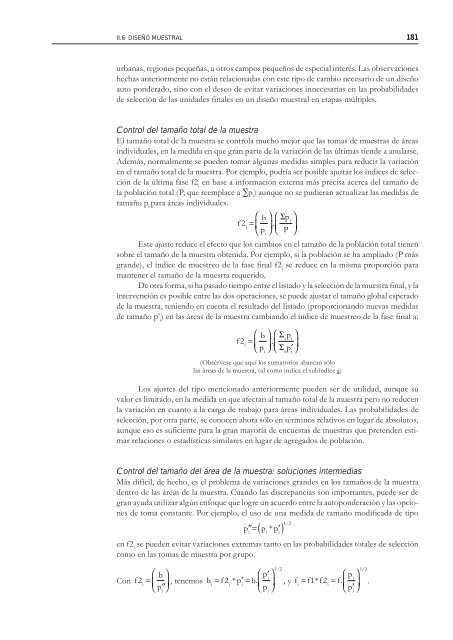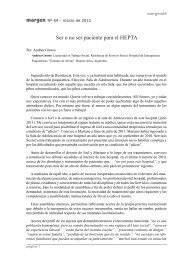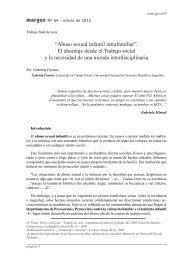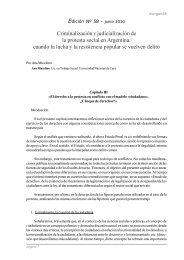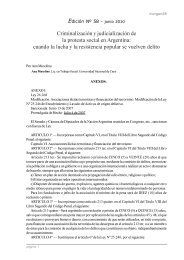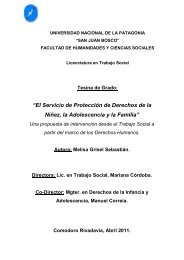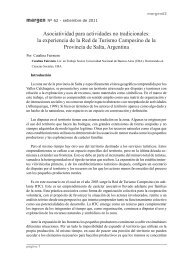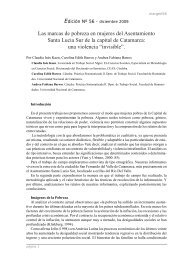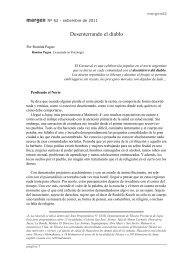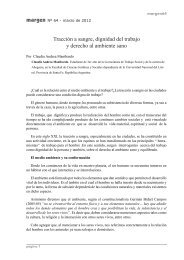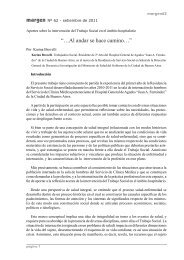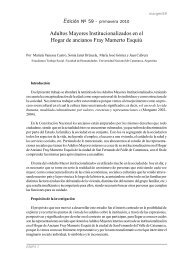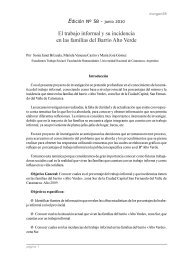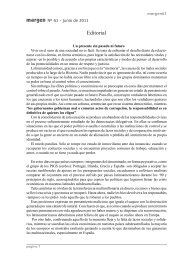- Page 1 and 2:
Ofi cina Internacional del Trabajo
- Page 3:
Este manual fue desarrollado y coor
- Page 6 and 7:
vi ESTADÍSTICAS DEL TRABAJO INFANT
- Page 8 and 9:
viii ESTADÍSTICAS DEL TRABAJO INFA
- Page 11 and 12:
xi Lista de siglas AE ASCII BAD BBS
- Page 13 and 14:
xiii Prólogo Durante los últimos
- Page 15:
1 Primera parte ANTECEDENTES E INTR
- Page 18 and 19:
4 ESTADÍSTICAS DEL TRABAJO INFANTI
- Page 20 and 21:
6 ESTADÍSTICAS DEL TRABAJO INFANTI
- Page 22 and 23:
8 ESTADÍSTICAS DEL TRABAJO INFANTI
- Page 24 and 25:
10 ESTADÍSTICAS DEL TRABAJO INFANT
- Page 26 and 27:
12 ESTADÍSTICAS DEL TRABAJO INFANT
- Page 28 and 29:
14 ESTADÍSTICAS DEL TRABAJO INFANT
- Page 30 and 31:
16 ESTADÍSTICAS DEL TRABAJO INFANT
- Page 32 and 33:
18 ESTADÍSTICAS DEL TRABAJO INFANT
- Page 34 and 35:
20 ESTADÍSTICAS DEL TRABAJO INFANT
- Page 36 and 37:
22 ESTADÍSTICAS DEL TRABAJO INFANT
- Page 38 and 39:
24 ESTADÍSTICAS DEL TRABAJO INFANT
- Page 40 and 41:
26 ESTADÍSTICAS DEL TRABAJO INFANT
- Page 42 and 43:
28 ESTADÍSTICAS DEL TRABAJO INFANT
- Page 44 and 45:
30 ESTADÍSTICAS DEL TRABAJO INFANT
- Page 46 and 47:
32 ESTADÍSTICAS DEL TRABAJO INFANT
- Page 48 and 49:
34 ESTADÍSTICAS DEL TRABAJO INFANT
- Page 50 and 51:
36 ESTADÍSTICAS DEL TRABAJO INFANT
- Page 52 and 53:
38 ESTADÍSTICAS DEL TRABAJO INFANT
- Page 54 and 55:
40 ESTADÍSTICAS DEL TRABAJO INFANT
- Page 56 and 57:
42 ESTADÍSTICAS DEL TRABAJO INFANT
- Page 58 and 59:
44 ESTADÍSTICAS DEL TRABAJO INFANT
- Page 60 and 61:
46 ESTADÍSTICAS DEL TRABAJO INFANT
- Page 62 and 63:
48 ESTADÍSTICAS DEL TRABAJO INFANT
- Page 64 and 65:
50 ESTADÍSTICAS DEL TRABAJO INFANT
- Page 66 and 67:
52 ESTADÍSTICAS DEL TRABAJO INFANT
- Page 68 and 69:
54 ESTADÍSTICAS DEL TRABAJO INFANT
- Page 70 and 71:
56 ESTADÍSTICAS DEL TRABAJO INFANT
- Page 72 and 73:
58 ESTADÍSTICAS DEL TRABAJO INFANT
- Page 74 and 75:
60 ESTADÍSTICAS DEL TRABAJO INFANT
- Page 76 and 77:
62 ESTADÍSTICAS DEL TRABAJO INFANT
- Page 78 and 79:
64 ESTADÍSTICAS DEL TRABAJO INFANT
- Page 80 and 81:
66 ESTADÍSTICAS DEL TRABAJO INFANT
- Page 82 and 83:
68 ESTADÍSTICAS DEL TRABAJO INFANT
- Page 84 and 85:
70 ESTADÍSTICAS DEL TRABAJO INFANT
- Page 86 and 87:
72 ESTADÍSTICAS DEL TRABAJO INFANT
- Page 88 and 89:
74 ESTADÍSTICAS DEL TRABAJO INFANT
- Page 91:
77 Segunda parte ENCUESTA DE HOGARE
- Page 94 and 95:
80 ESTADÍSTICAS DEL TRABAJO INFANT
- Page 96 and 97:
82 ESTADÍSTICAS DEL TRABAJO INFANT
- Page 98 and 99:
84 ESTADÍSTICAS DEL TRABAJO INFANT
- Page 100 and 101:
86 ESTADÍSTICAS DEL TRABAJO INFANT
- Page 102 and 103:
88 ESTADÍSTICAS DEL TRABAJO INFANT
- Page 104 and 105:
90 ESTADÍSTICAS DEL TRABAJO INFANT
- Page 106 and 107:
92 ESTADÍSTICAS DEL TRABAJO INFANT
- Page 108 and 109:
94 ESTADÍSTICAS DEL TRABAJO INFANT
- Page 110 and 111:
96 ESTADÍSTICAS DEL TRABAJO INFANT
- Page 112 and 113:
98 ESTADÍSTICAS DEL TRABAJO INFANT
- Page 114 and 115:
100 ESTADÍSTICAS DEL TRABAJO INFAN
- Page 116 and 117:
102 ESTADÍSTICAS DEL TRABAJO INFAN
- Page 118 and 119:
104 ESTADÍSTICAS DEL TRABAJO INFAN
- Page 120 and 121:
106 ESTADÍSTICAS DEL TRABAJO INFAN
- Page 122 and 123:
108 ESTADÍSTICAS DEL TRABAJO INFAN
- Page 124 and 125:
110 ESTADÍSTICAS DEL TRABAJO INFAN
- Page 126 and 127:
112 ESTADÍSTICAS DEL TRABAJO INFAN
- Page 128 and 129:
114 ESTADÍSTICAS DEL TRABAJO INFAN
- Page 130 and 131:
116 ESTADÍSTICAS DEL TRABAJO INFAN
- Page 132 and 133:
118 ESTADÍSTICAS DEL TRABAJO INFAN
- Page 134 and 135:
120 ESTADÍSTICAS DEL TRABAJO INFAN
- Page 136 and 137:
122 ESTADÍSTICAS DEL TRABAJO INFAN
- Page 138 and 139:
124 ESTADÍSTICAS DEL TRABAJO INFAN
- Page 140 and 141:
126 ESTADÍSTICAS DEL TRABAJO INFAN
- Page 142 and 143:
128 ESTADÍSTICAS DEL TRABAJO INFAN
- Page 144 and 145: 130 ESTADÍSTICAS DEL TRABAJO INFAN
- Page 146 and 147: 132 ESTADÍSTICAS DEL TRABAJO INFAN
- Page 148 and 149: 134 ESTADÍSTICAS DEL TRABAJO INFAN
- Page 150 and 151: 136 ESTADÍSTICAS DEL TRABAJO INFAN
- Page 152 and 153: 138 ESTADÍSTICAS DEL TRABAJO INFAN
- Page 154 and 155: 140 ESTADÍSTICAS DEL TRABAJO INFAN
- Page 156 and 157: 142 ESTADÍSTICAS DEL TRABAJO INFAN
- Page 158 and 159: 144 ESTADÍSTICAS DEL TRABAJO INFAN
- Page 160 and 161: 146 ESTADÍSTICAS DEL TRABAJO INFAN
- Page 162 and 163: 148 ESTADÍSTICAS DEL TRABAJO INFAN
- Page 164 and 165: 150 ESTADÍSTICAS DEL TRABAJO INFAN
- Page 166 and 167: 152 ESTADÍSTICAS DEL TRABAJO INFAN
- Page 168 and 169: 154 ESTADÍSTICAS DEL TRABAJO INFAN
- Page 170 and 171: 156 ESTADÍSTICAS DEL TRABAJO INFAN
- Page 172 and 173: 158 ESTADÍSTICAS DEL TRABAJO INFAN
- Page 174 and 175: 160 ESTADÍSTICAS DEL TRABAJO INFAN
- Page 176 and 177: 162 ESTADÍSTICAS DEL TRABAJO INFAN
- Page 178 and 179: 164 ESTADÍSTICAS DEL TRABAJO INFAN
- Page 180 and 181: 166 ESTADÍSTICAS DEL TRABAJO INFAN
- Page 182 and 183: 168 ESTADÍSTICAS DEL TRABAJO INFAN
- Page 184 and 185: 170 ESTADÍSTICAS DEL TRABAJO INFAN
- Page 186 and 187: 172 ESTADÍSTICAS DEL TRABAJO INFAN
- Page 188 and 189: 174 ESTADÍSTICAS DEL TRABAJO INFAN
- Page 190 and 191: 176 ESTADÍSTICAS DEL TRABAJO INFAN
- Page 192 and 193: 178 ESTADÍSTICAS DEL TRABAJO INFAN
- Page 196 and 197: 182 ESTADÍSTICAS DEL TRABAJO INFAN
- Page 198 and 199: 184 ESTADÍSTICAS DEL TRABAJO INFAN
- Page 200 and 201: 186 ESTADÍSTICAS DEL TRABAJO INFAN
- Page 202 and 203: 188 ESTADÍSTICAS DEL TRABAJO INFAN
- Page 204 and 205: 190 ESTADÍSTICAS DEL TRABAJO INFAN
- Page 206 and 207: 192 ESTADÍSTICAS DEL TRABAJO INFAN
- Page 208 and 209: 194 ESTADÍSTICAS DEL TRABAJO INFAN
- Page 210 and 211: 196 ESTADÍSTICAS DEL TRABAJO INFAN
- Page 212 and 213: 198 ESTADÍSTICAS DEL TRABAJO INFAN
- Page 214 and 215: 200 ESTADÍSTICAS DEL TRABAJO INFAN
- Page 216 and 217: 202 ESTADÍSTICAS DEL TRABAJO INFAN
- Page 218 and 219: 204 ESTADÍSTICAS DEL TRABAJO INFAN
- Page 220 and 221: 206 ESTADÍSTICAS DEL TRABAJO INFAN
- Page 222 and 223: 208 ESTADÍSTICAS DEL TRABAJO INFAN
- Page 224 and 225: 210 ESTADÍSTICAS DEL TRABAJO INFAN
- Page 226 and 227: 212 ESTADÍSTICAS DEL TRABAJO INFAN
- Page 228 and 229: 214 ESTADÍSTICAS DEL TRABAJO INFAN
- Page 230 and 231: 216 ESTADÍSTICAS DEL TRABAJO INFAN
- Page 232 and 233: 218 ESTADÍSTICAS DEL TRABAJO INFAN
- Page 234 and 235: 220 ESTADÍSTICAS DEL TRABAJO INFAN
- Page 236 and 237: 222 ESTADÍSTICAS DEL TRABAJO INFAN
- Page 238 and 239: 224 ESTADÍSTICAS DEL TRABAJO INFAN
- Page 240 and 241: 226 ESTADÍSTICAS DEL TRABAJO INFAN
- Page 242 and 243: 228 ESTADÍSTICAS DEL TRABAJO INFAN
- Page 244 and 245:
230 ESTADÍSTICAS DEL TRABAJO INFAN
- Page 247 and 248:
233 Preparación para la recolecci
- Page 249 and 250:
II.8 PREPARACIÓN PARA LA RECOLECCI
- Page 251 and 252:
II.8 PREPARACIÓN PARA LA RECOLECCI
- Page 253 and 254:
II.8 PREPARACIÓN PARA LA RECOLECCI
- Page 255 and 256:
II.8 PREPARACIÓN PARA LA RECOLECCI
- Page 257 and 258:
II.8 PREPARACIÓN PARA LA RECOLECCI
- Page 259 and 260:
II.8 PREPARACIÓN PARA LA RECOLECCI
- Page 261 and 262:
II.8 PREPARACIÓN PARA LA RECOLECCI
- Page 263:
II.8 PREPARACIÓN PARA LA RECOLECCI
- Page 266 and 267:
252 ESTADÍSTICAS DEL TRABAJO INFAN
- Page 268 and 269:
254 ESTADÍSTICAS DEL TRABAJO INFAN
- Page 270 and 271:
256 ESTADÍSTICAS DEL TRABAJO INFAN
- Page 272 and 273:
258 ESTADÍSTICAS DEL TRABAJO INFAN
- Page 274 and 275:
260 ESTADÍSTICAS DEL TRABAJO INFAN
- Page 276 and 277:
262 ESTADÍSTICAS DEL TRABAJO INFAN
- Page 278 and 279:
264 ESTADÍSTICAS DEL TRABAJO INFAN
- Page 281 and 282:
267 Codificación II.10 10.1 ■ In
- Page 283 and 284:
II.10 CODIFICACIÓN 269 la muestra
- Page 285 and 286:
II.10 CODIFICACIÓN 271 Función de
- Page 287 and 288:
II.10 CODIFICACIÓN 273 El hecho de
- Page 289 and 290:
II.10 CODIFICACIÓN 275 10.3.3 ❚
- Page 291 and 292:
II.10 CODIFICACIÓN 277 Costes rela
- Page 293 and 294:
II.10 CODIFICACIÓN 279 Industria.
- Page 295 and 296:
II.10 CODIFICACIÓN 281 10.6.3 ❚
- Page 297 and 298:
283 Procesamiento de datos II.11 11
- Page 299 and 300:
II.11 PROCESAMIENTO DE DATOS 285 di
- Page 301 and 302:
II.11 PROCESAMIENTO DE DATOS 287 Cu
- Page 303 and 304:
II.11 PROCESAMIENTO DE DATOS 289 11
- Page 305 and 306:
II.11 PROCESAMIENTO DE DATOS 291 11
- Page 307 and 308:
II.11 PROCESAMIENTO DE DATOS 293 La
- Page 309 and 310:
II.11 PROCESAMIENTO DE DATOS 295 Pa
- Page 311 and 312:
297 Análisis de datos e informes I
- Page 313 and 314:
II.12 ANÁLISIS DE DATOS E INFORMES
- Page 315 and 316:
II.12 ANÁLISIS DE DATOS E INFORMES
- Page 317 and 318:
II.12 ANÁLISIS DE DATOS E INFORMES
- Page 319 and 320:
II.12 ANÁLISIS DE DATOS E INFORMES
- Page 321 and 322:
II.12 ANÁLISIS DE DATOS E INFORMES
- Page 323 and 324:
309 Tercera parte MÉTODOS COMPLEME
- Page 325 and 326:
311 Evaluaciones rápidas III.13 13
- Page 327 and 328:
III.13 EVALUACIONES RÁPIDAS 313 Es
- Page 329 and 330:
III.13 EVALUACIONES RÁPIDAS 315 C
- Page 331 and 332:
III.13 EVALUACIONES RÁPIDAS 317 Re
- Page 333 and 334:
III.13 EVALUACIONES RÁPIDAS 319 d
- Page 335 and 336:
III.13 EVALUACIONES RÁPIDAS 321 s
- Page 337 and 338:
III.13 EVALUACIONES RÁPIDAS 323 Pu
- Page 339 and 340:
III.13 EVALUACIONES RÁPIDAS 325 13
- Page 341 and 342:
III.13 EVALUACIONES RÁPIDAS 327 13
- Page 343 and 344:
III.13 EVALUACIONES RÁPIDAS 329 de
- Page 345 and 346:
III.13 EVALUACIONES RÁPIDAS 331 13
- Page 347 and 348:
III.13 EVALUACIONES RÁPIDAS 333 je
- Page 349 and 350:
III.13 EVALUACIONES RÁPIDAS 335 C
- Page 351 and 352:
III.13 EVALUACIONES RÁPIDAS 337 13
- Page 353 and 354:
III.13 EVALUACIONES RÁPIDAS 339 S
- Page 355 and 356:
III.13 EVALUACIONES RÁPIDAS 341 Re
- Page 357 and 358:
III.13 EVALUACIONES RÁPIDAS 343 Mo
- Page 359 and 360:
III.13 EVALUACIONES RÁPIDAS 345 Ob
- Page 361 and 362:
III.13 EVALUACIONES RÁPIDAS 347 e
- Page 363 and 364:
III.13 EVALUACIONES RÁPIDAS 349 Re
- Page 365 and 366:
III.13 EVALUACIONES RÁPIDAS 351 -
- Page 367 and 368:
III.13 EVALUACIONES RÁPIDAS 353 An
- Page 369 and 370:
III.13 EVALUACIONES RÁPIDAS 355 An
- Page 371 and 372:
III.13 EVALUACIONES RÁPIDAS 357 6.
- Page 373 and 374:
III.13 EVALUACIONES RÁPIDAS 359 Bl
- Page 375 and 376:
III.13 EVALUACIONES RÁPIDAS 361 16
- Page 377 and 378:
III.13 EVALUACIONES RÁPIDAS 363 38
- Page 379 and 380:
III.13 EVALUACIONES RÁPIDAS 365 An
- Page 381 and 382:
III.13 EVALUACIONES RÁPIDAS 367 Ej
- Page 383:
III.13 EVALUACIONES RÁPIDAS 369 S
- Page 386 and 387:
372 ESTADÍSTICAS DEL TRABAJO INFAN
- Page 388 and 389:
374 ESTADÍSTICAS DEL TRABAJO INFAN
- Page 390 and 391:
376 ESTADÍSTICAS DEL TRABAJO INFAN
- Page 392 and 393:
378 ESTADÍSTICAS DEL TRABAJO INFAN
- Page 394 and 395:
380 ESTADÍSTICAS DEL TRABAJO INFAN
- Page 396 and 397:
382 ESTADÍSTICAS DEL TRABAJO INFAN
- Page 398 and 399:
384 ESTADÍSTICAS DEL TRABAJO INFAN
- Page 400 and 401:
386 ESTADÍSTICAS DEL TRABAJO INFAN
- Page 402 and 403:
388 ESTADÍSTICAS DEL TRABAJO INFAN
- Page 404 and 405:
390 ESTADÍSTICAS DEL TRABAJO INFAN
- Page 406 and 407:
392 ESTADÍSTICAS DEL TRABAJO INFAN
- Page 408 and 409:
394 ESTADÍSTICAS DEL TRABAJO INFAN
- Page 410 and 411:
396 ESTADÍSTICAS DEL TRABAJO INFAN
- Page 412 and 413:
398 ESTADÍSTICAS DEL TRABAJO INFAN
- Page 414 and 415:
400 ESTADÍSTICAS DEL TRABAJO INFAN
- Page 416 and 417:
402 ESTADÍSTICAS DEL TRABAJO INFAN
- Page 418 and 419:
404 ESTADÍSTICAS DEL TRABAJO INFAN
- Page 421 and 422:
407 Encuesta escolar III.16 16.1
- Page 423 and 424:
III.16 ENCUESTA ESCOLAR 409 16.3
- Page 425 and 426:
III.16 ENCUESTA ESCOLAR 411 16.4.3
- Page 427 and 428:
III.16 ENCUESTA ESCOLAR 413 Anexo E
- Page 429 and 430:
III.16 ENCUESTA ESCOLAR 415 30. Si
- Page 431 and 432:
III.16 ENCUESTA ESCOLAR 417 39. ¿P
- Page 433 and 434:
III.16 ENCUESTA ESCOLAR 419 Cuestio
- Page 435 and 436:
III.16 ENCUESTA ESCOLAR 421 25. ¿P
- Page 437 and 438:
III.16 ENCUESTA ESCOLAR 423 7. Impo
- Page 439 and 440:
425 Encuesta de línea de base III.
- Page 441 and 442:
III.17 ENCUESTA DE LÍNEA DE BASE 4
- Page 443 and 444:
III.17 ENCUESTA DE LÍNEA DE BASE 4
- Page 445 and 446:
III.17 ENCUESTA DE LÍNEA DE BASE 4
- Page 447 and 448:
III.17 ENCUESTA DE LÍNEA DE BASE 4
- Page 449 and 450:
III.17 ENCUESTA DE LÍNEA DE BASE 4
- Page 451 and 452:
III.17 ENCUESTA DE LÍNEA DE BASE 4
- Page 453 and 454:
III.17 ENCUESTA DE LÍNEA DE BASE 4
- Page 455 and 456:
III.17 ENCUESTA DE LÍNEA DE BASE 4
- Page 457 and 458:
III.17 ENCUESTA DE LÍNEA DE BASE 4
- Page 459 and 460:
III.17 ENCUESTA DE LÍNEA DE BASE 4
- Page 461 and 462:
III.17 ENCUESTA DE LÍNEA DE BASE 4
- Page 463 and 464:
III.17 ENCUESTA DE LÍNEA DE BASE 4
- Page 465 and 466:
III.17 ENCUESTA DE LÍNEA DE BASE 4
- Page 467 and 468:
III.17 ENCUESTA DE LÍNEA DE BASE 4
- Page 469 and 470:
III.17 ENCUESTA DE LÍNEA DE BASE 4
- Page 471 and 472:
III.17 ENCUESTA DE LÍNEA DE BASE 4
- Page 473 and 474:
III.17 ENCUESTA DE LÍNEA DE BASE 4
- Page 475 and 476:
III.17 ENCUESTA DE LÍNEA DE BASE 4
- Page 477 and 478:
III.17 ENCUESTA DE LÍNEA DE BASE 4
- Page 479 and 480:
III.17 ENCUESTA DE LÍNEA DE BASE 4
- Page 481 and 482:
III.17 ENCUESTA DE LÍNEA DE BASE 4
- Page 483 and 484:
III.17 ENCUESTA DE LÍNEA DE BASE 4
- Page 485 and 486:
III.17 ENCUESTA DE LÍNEA DE BASE 4
- Page 487 and 488:
III.17 ENCUESTA DE LÍNEA DE BASE 4
- Page 489 and 490:
III.17 ENCUESTA DE LÍNEA DE BASE 4
- Page 491 and 492:
III.17 ENCUESTA DE LÍNEA DE BASE 4
- Page 493 and 494:
III.17 ENCUESTA DE LÍNEA DE BASE 4
- Page 495 and 496:
III.17 ENCUESTA DE LÍNEA DE BASE 4
- Page 497 and 498:
III.17 ENCUESTA DE LÍNEA DE BASE 4
- Page 499 and 500:
III.17 ENCUESTA DE LÍNEA DE BASE 4
- Page 501:
III.17 ENCUESTA DE LÍNEA DE BASE 4
- Page 504 and 505:
490 ESTADÍSTICAS DEL TRABAJO INFAN
- Page 506 and 507:
492 ESTADÍSTICAS DEL TRABAJO INFAN
- Page 508 and 509:
494 ESTADÍSTICAS DEL TRABAJO INFAN
- Page 510 and 511:
496 ESTADÍSTICAS DEL TRABAJO INFAN
- Page 512 and 513:
498 ESTADÍSTICAS DEL TRABAJO INFAN
- Page 515 and 516:
APÉNDICES - III 501 ENCUESTA NACIO
- Page 517 and 518:
APÉNDICES - III 503 Sección II Ed
- Page 519 and 520:
APÉNDICES - III 505 Sección III S
- Page 521 and 522:
APÉNDICES - III 507 Sección III S
- Page 523 and 524:
APÉNDICES - III 509 Sección IV Si
- Page 525 and 526:
APÉNDICES - III 511 Sección V Tra
- Page 527 and 528:
APÉNDICES - III 513 Sección VII A
- Page 529:
APÉNDICES - III 515 Sección IX Co
- Page 532 and 533:
518 ESTADÍSTICAS DEL TRABAJO INFAN
- Page 534 and 535:
520 ESTADÍSTICAS DEL TRABAJO INFAN
- Page 536 and 537:
522 ESTADÍSTICAS DEL TRABAJO INFAN
- Page 538 and 539:
524 ESTADÍSTICAS DEL TRABAJO INFAN
- Page 540 and 541:
526 ESTADÍSTICAS DEL TRABAJO INFAN
- Page 543 and 544:
529 Referencias bibliográficas Abu
- Page 545 and 546:
REFERENCIAS BIBLIOGRÁFICAS 531 —
- Page 547:
REFERENCIAS BIBLIOGRÁFICAS 533 Uni


